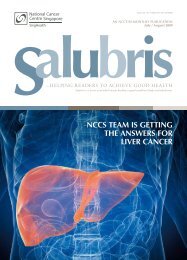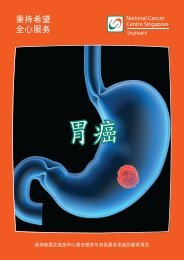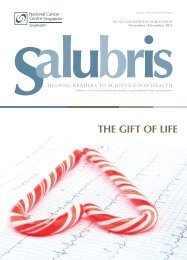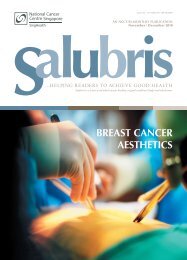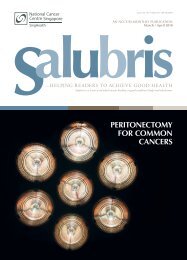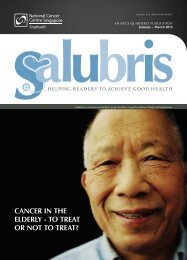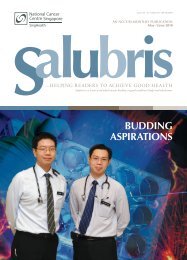Medical Professionals Version - National Cancer Centre Singapore
Medical Professionals Version - National Cancer Centre Singapore
Medical Professionals Version - National Cancer Centre Singapore
You also want an ePaper? Increase the reach of your titles
YUMPU automatically turns print PDFs into web optimized ePapers that Google loves.
PAGE C4<br />
Spotlight<br />
SALUBRIS<br />
July / August 2009<br />
RATIONAL APPROACH TO<br />
TESTICULAR SWELLING<br />
Continued from page C3.<br />
Some 90% of testicular torsions occur in<br />
men younger than 30 years old. A teenager<br />
with sudden onset scrotal pain and a normal<br />
urinalysis most likely has testicular torsion.<br />
Unrelieved torsion (longer than six hours)<br />
leads to testicular ischemia and atrophy. A<br />
delay in diagnosis longer than 12 hours will<br />
result in irreversible damage.<br />
Testicular torsion can be confirmed by<br />
Doppler ultrasound (greater than 90%<br />
sensitivity, 70% specificity). However, if in<br />
doubt, scrotal exploration and detorsion<br />
should always be performed. The common<br />
anatomical defect is high “investment” of the<br />
tunica vaginalis – the so called bell-clapper<br />
deformity. This inherent defect is usually<br />
bilateral, and detorsion should always be<br />
followed by testicular fixation (orchiopexy)<br />
of both gonads.<br />
If epididymitis or epididymo-orchitis is<br />
diagnosed especially with the finding of<br />
pus cells and bacteria on urine microscopy,<br />
the patient can be treated with a course of<br />
bactrim and doxycycline for two weeks. The<br />
etiology is commonly bacterial infection of<br />
the urinary tract.<br />
In sexually active young adults especially<br />
when associated with urethritis, chlamydial<br />
and neisseria gonorrhoeae infection must be<br />
considered. It is prudent to review the patients<br />
after treatment for resolution of symptoms<br />
and signs. If in doubt, an ultrasound scrotum<br />
should be ordered. An underlying testicular<br />
malignancy must still be a consideration.<br />
Testicular cancer is the most frequent cancer<br />
in young men (15 to 35 years of age).<br />
Cryptorchidism is a well-known risk factor<br />
even after orchiopexy. Testicular tumours<br />
usually present as painless lumps, but some<br />
men (20-25%) develop scrotal pain as a result<br />
of bleeding caused by rapid tumour growth<br />
and necrosis. Most tumours are discovered<br />
as hard testicular lumps detected on self<br />
examination. Reactive hydrocele may make<br />
appreciation of a testicular lesion difficult.<br />
Scrotal ultrasound is an excellent modality for the assessment of testicular<br />
mass. Testicular cancers are typically non-homogenous with hypoechoic<br />
areas. Testicular microcalcifications are associated with a high propensity for<br />
developing seminomas and warrants regular ultrasound surveillance.<br />
More than 95% of testicular tumours originate from germ cells. Germ cell<br />
tumours can be seminomas or nonseminomatous germ cell tumours. Seminomas<br />
are more likely to be confined to the testis (stage I) and are exquisitely<br />
radiosensitive. Nonseminomatous germ cell tumours consist of embryonal cell<br />
carcinomas, yolk sac tumours, or teratomas, alone or mixed with other elements.<br />
Sertoli cell tumours, Leydig cell tumours, and lymphomas are the most-common<br />
non-germ cell tumours. In men older than 60 years, most tumours are non-<br />
Hodgkin’s lymphoma, with a predilection for bilateral involvement.<br />
Tumour markers are helpful in the diagnosis, staging and management of malignant<br />
testicular tumours. α-fetoprotein (AFP) is often associated with embryonal<br />
carcinoma, whereas β-subunit of human chorionic gonadotropin (β-hCG)<br />
elevations occur with choriocarcinomas. However, many testicular cancers are<br />
mixed germ cell in origin and tumour marker elevation is variable. Persistent<br />
elevation of tumour markers post orchiectomy suggests the presence of metastatic<br />
disease. However, there is a 25% false-negative marker elevation rate.<br />
Avoidance of scrotal skin violation is mandatory when obtaining histological<br />
diagnosis. The lymphatics of the testes drain primarily into the retroperitoneal<br />
para-aortic and inter-aortocaval lymph nodes while the scrotal skin lymphatics<br />
drain into the inguinal nodes. Trans-scrotal needle biopsy or orchiectomy is<br />
therefore contraindicated. Suspected testicular tumours should be explored via<br />
an inguinal incision with early control of the spermatic cord to prevent vascular<br />
or lymphatic dissemination.<br />
Further treatment is based on histological<br />
assessment of the tumour and staging<br />
consisting of computed tomography (CT)<br />
scanning and chest x-ray. A false-negative<br />
rate on 20 to 25% occurs in the presence<br />
of non-enlarged (smaller than 1.5cm) but<br />
microscopically involved retroperitoneal<br />
lymph nodes. Treatment modalities include<br />
retroperitoneal lymphadenectomy, external<br />
beam radiation to the retroperitoneum and<br />
chemotherapy, alone or in combination.



